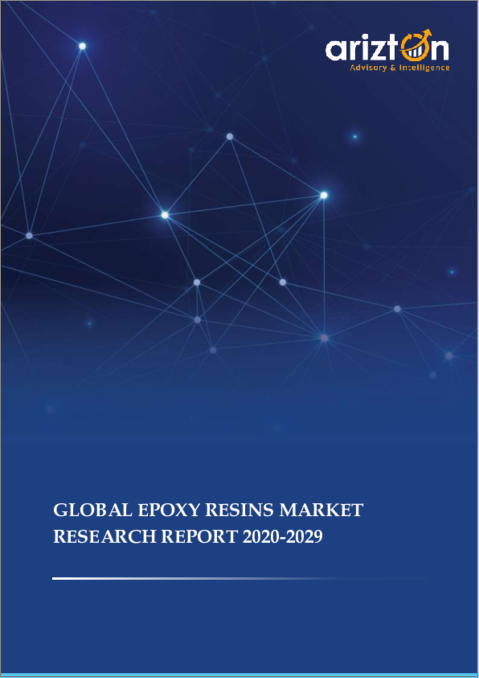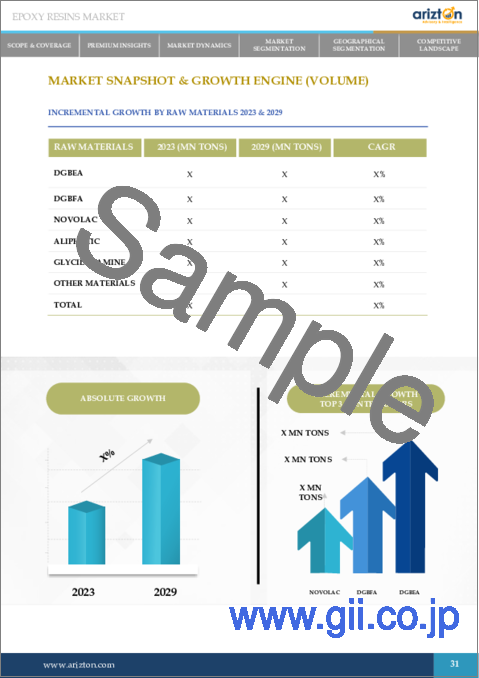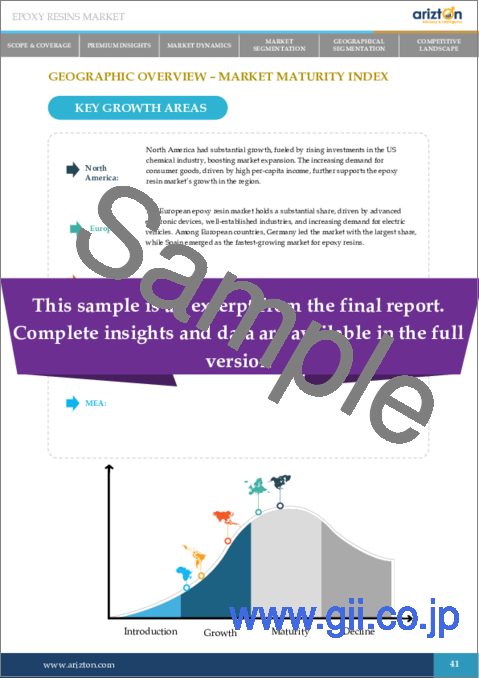|
|
市場調査レポート
商品コード
1641378
エポキシ樹脂の世界市場:2020年~2029年Global Epoxy Resins Market Research Report 2020-2029 |
||||||
|
|||||||
| エポキシ樹脂の世界市場:2020年~2029年 |
|
出版日: 2025年01月21日
発行: Arizton Advisory & Intelligence
ページ情報: 英文 285 Pages
納期: 即納可能
|
全表示
- 概要
- 目次
世界のエポキシ樹脂の市場規模は、2023年から2029年にかけてCAGR 5.10%で成長すると予測されています。
自動車、建築、エレクトロニクスにおけるエポキシ樹脂の需要の高まりが、エポキシ樹脂の成長を支えています。エポキシ樹脂は効率的な耐熱性、耐久性、接着特性を備えており、自動車用コーティング、接着剤、複合材料に適した選択肢となっています。さらに、技術の進歩により、熱安定性が向上し、機械的強度が強化され、硬化時間が短い高性能エポキシ樹脂の製造も可能になっています。例えば、Huntsmanのアラルダイトシリーズは、構造用接着剤に使用される高性能エポキシ樹脂で、特に航空宇宙やエレクトロニクスなどの分野で、速硬化、高耐熱性、優れた機械的性能を特徴としています。
ナノテクノロジーの開発により、強度、耐久性、化学薬品や極端な温度に対する耐性が向上したエポキシ樹脂が誕生しました。さらに、硬化剤と添加剤の進歩により、硬化時間の短縮と接着特性の向上が可能になっています。また、持続可能なグリーン材料に対する意識の高まりも市場を後押ししており、エポキシ樹脂は環境への影響を低減するために再生可能なバイオベースの原料を使用して配合されています。バイオベースのエポキシ樹脂は、熱硬化性樹脂による環境への影響を軽減するために開発されています。
世界のエポキシ樹脂の市場規模は、2029年までに164億9,000万米ドルに達し、予測期間中にCAGR 5.10%で成長すると予測されます。同市場は、化学配合の進歩、産業用途の拡大、環境意識の高まり別大幅な成長を遂げています。原材料別では、2023年にはDGBEAセグメントが市場で最大の収益シェアを占めました。この成長の主な要因は、この樹脂の優れた機械的強度、耐薬品性、接着特性であり、コーティング、接着剤、複合材料などの用途に不可欠な材料となっています。2023年には、液状エポキシ樹脂がその汎用性と幅広い用途により市場を独占しています。液状であるため、コーティング、接着剤、封止材など、さまざまな方法別塗布を含め、加工が容易です。接着別では、2023年には、2液型エポキシ樹脂が、その汎用性の高い用途と優れた性能特性により、世界のエポキシ市場を独占しました。2液型エポキシ樹脂は、様々な基材や条件への適応性により、自動車、航空宇宙、建設、工業メンテナンスなど様々な産業で広く使用されています。
硬化方法別では、2023年では、低温硬化(室温)エポキシ樹脂が、その簡便性と汎用性により世界市場を独占しています。常温で硬化する低温硬化エポキシ樹脂は、塗布の容易さとエネルギーコストの削減という大きな利点を提供します。用途別では、2023年には、さまざまな用途で保護・装飾仕上げに広く使用されていることから、塗料・コーティング分野が世界のエポキシ市場を独占しています。
当レポートでは、世界のエポキシ樹脂市場について調査し、市場の概要とともに、原材料別、形状別、接着別、硬化方法別、用途別、エンドユーザー別、地域別の動向、および市場に参入する企業のプロファイルなどを提供しています。
目次
第1章 範囲と対象範囲
第2章 チャンスのポケット
第3章 イントロダクション
第4章 市場機会と動向
第5章 市場促進要因
第6章 市場抑制要因
第7章 市場情勢
- ファイブフォース分析
第8章 原材料別(市場規模と予測:2020年~2029年)
第9章 形状別(市場規模と予測:2020年~2029年)
第10章 接着別(市場規模と予測:2020年~2029年)
第11章 硬化方法別(市場規模と予測:2020年~2029年)
第12章 用途別(市場規模と予測:2020年~2029年)
第13章 エンドユーザー別(市場規模と予測:2020年~2029年)
第14章 地域別(市場規模と予測:2020年~2029年)
- アジア太平洋
- 中国
- 日本
- インド
- オーストラリア
- 韓国
- 北米
- 米国
- カナダ
- 欧州
- ドイツ
- 英国
- フランス
- イタリア
- スペイン
- スウェーデン
- オランダ
- ラテンアメリカ
- ブラジル
- メキシコ
- アルゼンチン
- チリ
- 中東・アフリカ
- 南アフリカ
- サウジアラビア
- アラブ首長国連邦
- トルコ
第15章 競合情勢
第16章 競争の概要
- 主な発展
第17章 主要企業プロファイル
第18章 その他の有名企業プロファイル
第19章 報告書の概要
The global epoxy resin market is expected to grow at a CAGR of 5.10% from 2023 to 2029.
The rising demand for epoxy resins in automotive, construction, and electronics supports the growth of epoxy resins. Epoxy resins offer efficient heat resistance, durability, and adhesion properties, which make them a better option for automotive coatings, adhesive, and composite materials. Furthermore, technological advances have also resulted in the manufacturing of high-performance epoxy resins with improved thermal stability, enhanced mechanical strength, and low curing time. For instance, Huntsman's Araldite series offers high-performance epoxy resins used in structural adhesives, featuring quick curing, high thermal resistance, and superior mechanical performance, specifically in sectors like aerospace and electronics.
The development of nanotechnology has led to the creation of epoxy resins with improved strength, durability, and resistance to chemicals and temperature extremes. In addition, advances in curing agents and additives have allowed for faster curing times and enhanced adhesion properties. Also, the market has been propelled by the growing awareness of sustainable and green materials, with epoxy resins being formulated with renewable and bio-based sources to reduce environmental impact. Bio-based epoxy resins have been developed to reduce the environmental impact driven by thermosetting resins.
KEY TAKEAWAYS
- The global epoxy resin market is anticipated to reach USD 16.49 billion by 2029 and grow at a CAGR of 5.10% (by value) during the forecast period. The market has witnessed substantial growth, driven by advances in chemical formulations, expanding industrial applications, and heightened environmental awareness.
- Based on raw materials, in 2023, the DGBEA segment held the largest revenue share in the market. This growth is primarily fueled by the resin's superior mechanical strength, chemical resistance, and adhesive properties, making it an essential material for applications, such as coatings, adhesives, and composite materials.
- Based on formulation, in 2023, liquid epoxy resins have dominated the market due to their versatility and wide range of applications. Their liquid form allows easy processing, including application through various methods, such as coatings, adhesives, and encapsulations.
- Based on bonding, in 2023, two-part epoxy resins dominated the global epoxy market due to their versatile applications and superior performance characteristics. Two-part epoxies are widely used across various industries, including automotive, aerospace, construction, and industrial maintenance, due to their adaptability to various substrates and conditions.
- Based on the curing method, in 2023, cold cure (room temperature) epoxy resins dominate the global market due to their simplicity and versatility. Cold cure epoxies, which cure at ambient temperatures, offer significant advantages in ease of application and reduced energy costs.
- Based on application, in 2023, the paints and coatings segment dominate the global epoxy market due to its extensive use in providing protective and decorative finishes across various applications.
MARKET TRENDS
Bio-based epoxy is a new, emerging biopolymer technology that provides a clean, renewable, and sustainable alternative to petroleum-based coatings. Compared to natural or synthetic epoxies, it is far more environmentally friendly. It is a completely renewable resource because it is made from biomass and has no byproducts or waste. Also, AI technologies have increasingly shaped the epoxy resin market, driving innovation, enhancing production processes, and enabling new applications across various industries. Artificial intelligence integration into this market has revolutionized how epoxy resins are formulated, manufactured, and applied, leading to greater efficiency, sustainability, and product performance.
Resin 3D Printing utilizes liquid resins to create highly accurate and detailed objects. It is a popular additive manufacturing technique for producing complex parts and components with extraordinary detail. This 3D printing type is also known as vat photopolymerization. In most resin 3D printers, the process starts with a build platform filled with liquid resin. Companies, such as Henkel, 3M, and Huntsman Corporation are also focused on developing specialized epoxy resins modified for 3D printing applications. For instance, Henkel has introduced the LOCTITE 3D printing portfolio, which includes epoxy-based materials that offer superior mechanical properties and thermal resistance.
MARKET DRIVERS
Technological innovations are crucial in the epoxy resin market, driving product quality, performance, and efficiency advances. These innovations enhance the properties of epoxy resin and open new possibilities for its application in various industries. Also, the growth in developing economies has played a substantial role in the development of the global automotive sector. With the rising demand for automotive vehicles in emerging economies, vendors have a significant market to capitalize upon. Furthermore, over the last few decades, booming urbanization and the growing population rates have driven the global construction industry. The construction industry expects growth due to significant commercial and infrastructural development opportunities.
INDUSTRY RESTRAINTS
In the global market for epoxy resins, raw material costs represent a significant portion of the overall production expenses, accounting for approximately 50%-60% of the total cost. Moreover, the epoxy resin market is experiencing increasing competition from a range of substitute materials, impacting its growth and market dynamics. These substitutes include polyester resins, vinyl ester resins, and casting resins. Each alternative offers distinct advantages that challenge the dominance of traditional epoxy resins, influencing market share and industry trends. Also, epoxy resins, despite their superior performance characteristics, such as high strength, durability, and chemical resistance, face scrutiny due to their environmental impact and the stringent regulatory landscape that governs their use.
SEGMENTATION INSIGHTS
INSIGHTS BY RAW MATERIALS
The global epoxy resin market by raw materials is segmented it DGBEA, DGBEF, novolac, aliphatic, glycidyl amine, and other materials. Based on raw materials, the DGBEA (Bisphenol A and ECH) has dominated the global market share. The market has been led by its heavy usage in aerospace, automotive, and wind energy industries. Its use in high-performance coatings ensures durability and resistance to environmental conditions. Furthermore, the novolac category is also anticipated to experience significant growth market during the forecast period, driven by its expanding use in surface applications, adhesives, and plastics across various industries. Novolac epoxy resins are valued for their exceptional heat resistance, chemical durability, and superior adhesion, making them ideal for high-performance coatings, corrosion-resistant linings, and electrical encapsulations.
Segmentation by Raw Material
- DGBEA
- DGBEF
- Novolac
- Aliphatic
- Glycidyl Amine
- Other Materials
INSIGHTS BY FORMULATION
The epoxy resin market by formulation is segmented into liquid, solid, and powder. In 2023, liquid epoxy resins have dominated the global market share due to their versatility and wide range of applications. Their liquid form allows easy processing, including application through various methods, such as coatings, adhesives, and encapsulations. Also, powder epoxy resins rapidly grew at a high CAGR because of several key advantages catering to emerging industry demands. The powder form of epoxies eliminates the need for solvents, making them environmentally friendly and safer by reducing volatile organic compound (VOC) emissions. Powder epoxies also offer superior durability, excellent adhesion, and resistance to abrasion and chemicals, making them ideal for high-performance coatings on industrial equipment, automotive parts, and infrastructure.
Segmentation by Formulation
- Liquid
- Solid
- Powder
INSIGHTS BY BONDING
In 2023, the two-part segment dominated the global epoxy resin market because it offers superior mechanical strength, thermal stability, and chemical resistance. Different ratios and formulations of the resin and hardener can be adjusted to meet specific application needs, such as varying curing times, flexibility, or environmental resistance. Furthermore, the one-part is growing at a high CAGR rate of 5.01% (by volume) due to its simplified application process, reduced labor time, minimized risk, and user-friendly for industrial and consumer applications. Also, the rising demand for one-part epoxies is supported by advances in formulation technology, which have enhanced their performance and expanded their range of applications.
Segmentation by Bonding
- Two-part
- One-part
- Three-part
INSIGHTS BY CURING METHOD
In 2023, cold-cure epoxy resins dominate the global epoxy resin market due to their simplicity and versatility. Cold cure epoxies, which cure at ambient temperatures, offer significant advantages in ease of application and reduced energy costs. Furthermore, thermal cure epoxies also grew in the market, driven by their enhanced performance properties. Thermal curing involves heating the epoxy resin to accelerate the curing process, resulting in a final product with improved mechanical strength, chemical resistance, and thermal stability.
Moisture-curing epoxies are growing due to their unique properties and adaptability. Their ability to cure without additional heat or complex equipment further enhances their appeal in various industrial and commercial applications. Furthermore, the global market is increasingly leaning toward UV-curing resins due to their efficiency, which aligns with the industry's demand for rapid processing and high-quality results.
Segmentation by Curing Method
- Cold Cure
- Thermal Cure
- UV-Curing
- Moisture Curing
- Other Methods
INSIGHTS BY APPLICATION
The epoxy resin market by application is segmented into paints & coatings, adhesives & sealants, composites, encapsulation, and other applications. In 2023, based on application, the paints and coating segment dominated the global market share and was estimated to lead the market through the forecast period. Epoxy coatings are extremely durable, offer higher corrosion protection mechanical strength, and are easy to apply & maintain. Also, focusing on sustainable and durable construction materials in North America and Europe has led to greater adoption of epoxy coatings, particularly in green building initiatives. Adhesives and sealants are widely used in construction, automotive, aerospace, and electronics for bonding metals, plastics, composites, and other materials.
The composite segment is the fastest growth in this market, growing at a CAGR rate of 5.68% (by value) because of the rapid adoption and increasing investment in wind energy projects worldwide. Also, encapsulation is another key application of epoxy resins, used primarily in the electronics industry to protect sensitive components from environmental damage and mechanical emphasis.
Segmentation by Application
- Paint & Coatings
- Adhesives & Sealants
- Composites
- Encapsulation
- Other Applications
INSIGHTS BY END-USER
The epoxy resin market by end-users is segmented into construction, automotive, electrical & electronics, manufacturing, power & energy, aerospace, and other end-users. The construction sector dominated the global market share because of the significant usage of epoxy resins in construction activities. Furthermore, in the automotive industry, epoxy resins are crucial for various applications, including adhesives for assembling vehicle parts, protective coatings, and high-strength composites used in lightweight components. Their role in enhancing vehicle performance and durability contributes significantly to the epoxy market as automakers seek advanced materials to meet stringent performance and safety standards.
The power and energy sectors saw a high growth rate in the global epoxy resin market, driven by the increasing use of epoxy resins in constructing and maintaining energy infrastructure, including power plants, wind turbines, and solar panels. Also, in the aerospace industry, epoxy resins produce high-strength, lightweight composites and adhesives critical for aircraft and spacecraft components. The need for advanced materials that offer strength and weight reduction supports the significant use of epoxies in aerospace applications.
Segmentation by End-Users
- Construction
- Automotive
- Electrical & Electronics
- Manufacturing
- Power & Energy
- Aerospace
- Other End-users
GEOGRAPHICAL ANALYSIS
APAC had the largest global epoxy resin market share of around 41% (by value) in 2023. With favorable growth of end-user industries in China, India, Japan, and other countries, the region is expected to lead this market even during the forecast period. Moreover, the continuously expanding composites market, construction & automotive industries have further boosted the demand for durable & sustainable epoxies. Furthermore, increasing digitization in North America has fueled demand for electrical & electronic systems. Epoxy-based, long-lasting & reliable components are used in these systems to reduce costs and improve performance.
In Europe, automotive, wind energy, and composites have driven the growth of low & high cured epoxy resins. Germany is the leading contributor to the growth of the market. Also, the demand for epoxy resins is majorly from the construction industry because of the increasing expenditure of consumers on home improvement, renovation, and remodeling activities in the EU. Furthermore, Latin America, the Middle East & Africa holds a smaller share, and these regions are anticipated to indicate faster growth in the global market. Technological innovations, rapid industrial development, changing government policies, and rising disposable income in these regions are aiding the growth of epoxy-based end-use industries.
Segmentation by Geography
- APAC
- China
- Japan
- India
- Australia
- South Korea
- North America
- The U.S.
- Canada
- Europe
- Germany
- The U.K.
- France
- Italy
- Spain
- Sweden
- Netherlands
- Latin America
- Brazil
- Mexico
- Argentina
- Chile
- Middle East & Africa
- South Africa
- Saudi Arabia
- UAE
- Turkey
VENDOR LANDSCAPE
The global epoxy resin market is characterized by a dynamic and competitive environment, featuring a blend of major international corporations and agile regional players striving for market dominance. With the growing competition in the industry, the key players, such as Kukdo, Huntsman, Hexion, and others, are focused on catering to the maximum production capacities to better serve the existing consumers.
The epoxy resin market saw significant technological advances as companies sought to differentiate their products and capture market share. Innovations in epoxy formulations are critical, with a strong focus on enhancing durability, chemical resistance, and environmental performance. Furthermore, the emergence of products that incorporate renewable raw materials or reduce the use of toxic components has gained traction. Companies that can effectively integrate green chemistry into their offerings are likely to achieve a competitive advantage, meeting the growing demand for environmentally responsible products. Also, sustainability is a major driving force in the epoxy resin market, as companies strive to align their products with global environmental standards. The shift toward eco-friendly solutions has led to bio-based epoxy resins and formulations that minimize harmful emissions.
Key Company Profiles
- Hexion
- Olin Corporation
- Huntsman
Other Prominent Company Profiles
- 3M
- BASF SE
- Dow Inc.
- Atul Ltd
- KUKDO CHEMICAL CO., LTD
- Sika AG
- NAN YA Plastics Industrial Co., Ltd.
- DIC Corporation
- Sanmu Group
- Chang Chun Group
- Sinopec (China Petrochemical Corporation)
- Kolon Industries
- Nagase & Co
- Grasim Industries Ltd (Aditya Birla Group)
- Covestro AG
- SABIC
- Henkel
- Gougeon Brothers
- GreenPoxy (Epoxy.com)
- EPOKE
- Magnifico
- Nama Chemicals
KEY QUESTIONS ANSWERED:
1. How big is the global epoxy resin market?
2. What is the growth rate of the global epoxy resin market?
3. Which region dominates the global epoxy resin market share?
4. What are the significant trends in the epoxy resin market?
5. Who are the key players in the global epoxy resin market?
TABLE OF CONTENTS
1. Scope & Coverage
- 1.1. Market Definition
- 1.2. Inclusions
- 1.3. Exclusions
- 1.4. Market Estimation Caveats
- 1.5. Market Size & Forecast Periods
- 1.5.1. Historic Period: 2020-2022
- 1.5.2. Base Year: 2023
- 1.5.3. Forecast Period: 2024-2029
- 1.6. Market Size (2020-2029)
- 1.6.1. Revenue
- 1.6.2. Volume
- 1.7. Market Segments
- 1.8. Market Segmentation by Raw Materials
- 1.9. Market Segmentation by Formulation
- 1.10. Market Segmentation by Bonding
- 1.11. Market Segmentation by Curing Method
- 1.12. Market Segmentation by Application
- 1.13. Market Segmentation by End-user
2. Opportunity Pockets
3. Introduction
4. Market Opportunities & Trends
- 4.1. Evolving Market of Bio-based Epoxy Resins
- 4.2. Emerging AI Technology in the Epoxy Resin Market
- 4.3. Innovations in the 3D Printing
5. Market Growth Enablers
- 5.1. Technological Advances
- 5.2. Rising Automotive Industry
- 5.3. Robust Growth in the Construction Sector
6. Market Restraints
- 6.1. Raw Material Price Volatility
- 6.2. Presence of Alternative Materials
- 6.3. Environmental Concerns & Regulatory Challenges
7. Market Landscape
- 7.1. Five Forces Analysis
8. Raw Materials (Market Size & Forecast: 2020-2029)
- 8.1. DGBEA
- 8.2. DGBEF
- 8.3. Novolac
- 8.4. Aliphatic
- 8.5. Glycidyl amine
- 8.6. Other Materials
9. Formulation (Market Size & Forecast: 2020-2029)
- 9.1. Liquid
- 9.2. Solid
- 9.3. Powder
10. Bonding (Market Size & Forecast: 2020-2029)
- 10.1. Two-part
- 10.2. One-part
- 10.3. Three-part
11. Curing Method (Market Size & Forecast: 2020-2029)
- 11.1. Cold Cure
- 11.2. Thermal Cure
- 11.3. UV-Curing
- 11.4. Moisture Curing
- 11.5. Other Methods
12. Application (Market Size & Forecast: 2020-2029)
- 12.1. Paints & Coatings
- 12.2. Adhesives & Sealants
- 12.3. Composites
- 12.4. Encapsulation
- 12.5. Other Applications
13. End-user (Market Size & Forecast: 2020-2029)
- 13.1. Construction
- 13.2. Automotive
- 13.3. Electrical & Electronics
- 13.4. Manufacturing
- 13.5. Power & Energy
- 13.6. Aerospace
- 13.7. Others
14. Geography (Market Size & Forecast: 2020-2029)
- 14.1. APAC
- 14.1.1. China
- 14.1.2. Japan
- 14.1.3. India
- 14.1.4. Australia
- 14.1.5. South Korea
- 14.2. North America
- 14.2.1. US
- 14.2.2. Canada
- 14.3. Europe
- 14.3.1. Germany
- 14.3.2. UK
- 14.3.3. France
- 14.3.4. Italy
- 14.3.5. Spain
- 14.3.6. Sweden
- 14.3.7. Netherlands
- 14.4. Latin America
- 14.4.1. Brazil
- 14.4.2. Mexico
- 14.4.3. Argentina
- 14.4.4. Chile
- 14.5. Middle East & Africa
- 14.5.1. South Africa
- 14.5.2. Saudi Arabia
- 14.5.3. UAE
- 14.5.4. Turkey
15. Competitive Landscape
16. Competitive Overview
- 16.1. Key Developments
17. Key Company Profiles
18. Other Prominent Company Profiles
19. Report Summary
- 19.1. Key Takeaways
- 19.2. Strategic Recommendations






